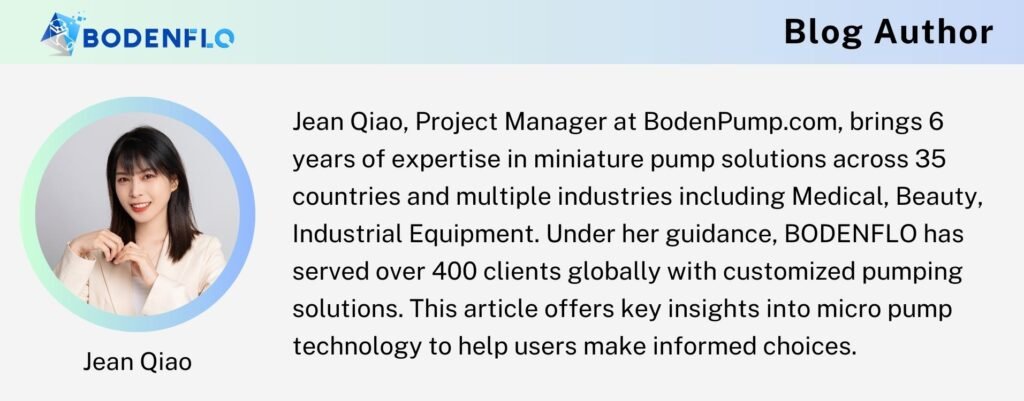Your high-speed inkjet printer keeps clogging, causing expensive downtime. The white ink seems to be the problem, settling in the tank and blocking nozzles. You need a reliable ink system.
A specialized diaphragm pump is the heart of the ink conditioning system. It provides the constant, powerful circulation needed to keep heavy white ink pigments perfectly suspended, feeding the printer a flawless supply of ink and preventing system-killing clogs.
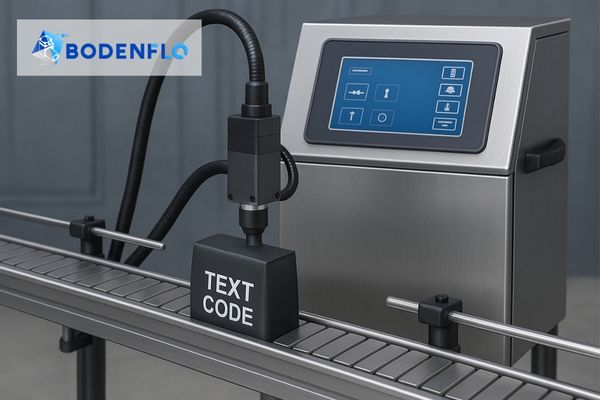
The secret to a reliable industrial printer isn't just its software; it's the mechanical heart of the fluid system. While a different component creates the final high pressure for printing, it's the main circulation pump that does the most critical job: preparing the ink. Let's break down exactly why this pump's role is so vital, especially when dealing with challenging inks like pigmented white.
What makes white ink so difficult to handle?
You expect your printer to work flawlessly, but white ink creates constant problems. It settles, clogs, and requires far more maintenance than standard inks, turning a reliable machine into a headache.
White ink's difficulty comes from its heavy titanium dioxide (TiO₂) pigments. Unlike dyes that dissolve, these solid particles quickly fall out of suspension, leading to inconsistent print density and severe printhead clogs if the ink isn't constantly agitated.
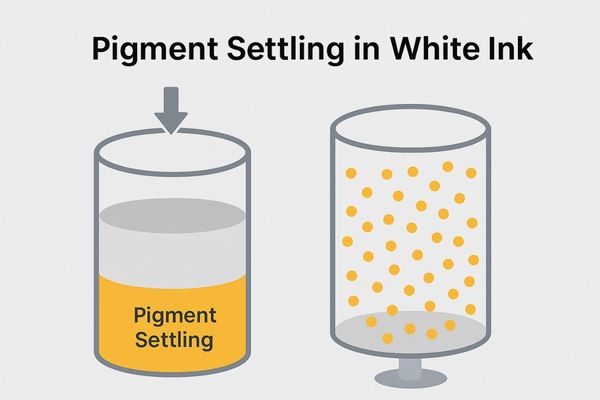
I've worked with many engineers developing coding systems, and white ink1 is always the biggest fluidic challenge. Standard black inks use fine carbon dyes that stay dissolved in the solvent. They are very stable. White ink, however, is more like a paint. It uses relatively large, heavy particles of titanium dioxide (TiO₂)2 to achieve its opacity.
When the printer is idle, gravity immediately goes to work, pulling these particles to the bottom of the 600ml ink reservoir3. This leads to two major failures: the ink at the top becomes too thin to print opaquely, and the thick sediment at the bottom gets sucked into the system, causing catastrophic clogs in the high-pressure pump and printhead.
What is the circulation pump's true role in the ink system?
You know you need to keep the ink moving, but how does that fit into the overall system? How do you get from a tank of conditioned ink to a perfectly printed code?
The system uses a two-stage approach. A robust diaphragm pump runs a "low-pressure loop" for circulation, and a separate component creates the final high pressure. The diaphragm pump's only job is to prevent settling and feed perfect ink to the pressure stage.
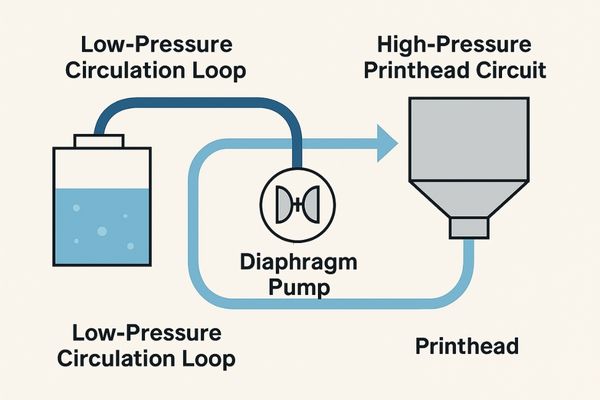
This is the most reliable way to engineer a CIJ system for difficult inks. The main diaphragm pump4 acts as the system's workhorse. Its sole purpose is to run the circulation and transfer loop. It continuously draws ink from the tank, moves it through the fluid lines, and returns the unused portion. This nonstop motion and robust flow is what keeps the heavy TiO₂ pigments5 evenly distributed.
Why is a diaphragm pump perfect for this? Because its gentle, positive displacement action6 is ideal for handling abrasive pigments without damaging them or the pump itself. It then delivers this perfectly mixed, conditioned ink to a different component (often a gear pump or pressure intensifier) that boosts the pressure for the final jetting. Our pump ensures the rest of the system never has to deal with bad ink.
Why is precise viscosity control also important?
Your ink is circulating perfectly, but the codes are still fuzzy. As the printer runs, solvents evaporate, making the ink too thick. This changes droplet velocity and leads to poor print quality.
A second, smaller micro pump automates this. Working with a viscosity sensor, this "makeup" pump precisely injects solvent into the ink tank whenever it thickens, ensuring perfect ink consistency automatically.
While the main circulation pump keeps the pigments suspended, this smaller pump performs the chemical fine-tuning7. The printer's LINUX operating system constantly monitors the ink's viscosity8 via a sensor. As solvents evaporate, the ink thickens. The moment the viscosity goes above the target, the controller signals the dedicated solvent pump. This micro diaphragm pump9 draws pure solvent from the makeup cartridge and injects a tiny, measured dose into the main ink tank. This happens automatically without stopping the printer. This division of labor is key: one robust pump for high-flow circulation, and one precision micro-pump for low-flow chemical balancing.
What defines a high-performance ink circulation pump?
You need a circulation pump, but how do you choose the right one? Simply picking any pump can lead to poor agitation, system starvation, or premature failure when used with aggressive inks.
A great ink circulation pump excels in three areas: high flow for agitation, strong suction to pull thick ink, and robust, chemically resistant materials for a long operational life.

When we design pumps for CIJ systems, we focus on the core engineering requirements that guarantee reliability. It’s not just about moving liquid; it’s about doing it under harsh conditions for thousands of hours. Here are the non-negotiable features:
Key Performance Metrics
- High Flow Rate: To prevent pigment settling, the entire volume of the ink tank needs to be turned over rapidly and continuously. A high flow rate ensures a turbulent environment inside the tank where particles can't settle.
- Strong Suction Power: Pigmented ink is more viscous than water. A pump needs powerful suction (a deep vacuum) to reliably lift the ink from the reservoir, especially when the ink level is low.
- Durability and Chemical Resistance10: The pump's internal components, especially the diaphragm and valves, must withstand constant contact with aggressive solvents and the abrasive nature of TiO₂ pigments. A long-life brushless motor is essential for 24/7 operation.
Which BODENFLO pumps are ideal for CIJ systems?
Your system needs a circulation pump, but which model is the right fit? Should you choose a standard model for a compact system, or a high-power version for a more demanding application?
BODENFLO offers tailored solutions. The BD-05TF700WB is perfect for standard systems, while the BD-05TF3000WB provides maximum performance for larger or more critical applications, ensuring you have the right power for the job.
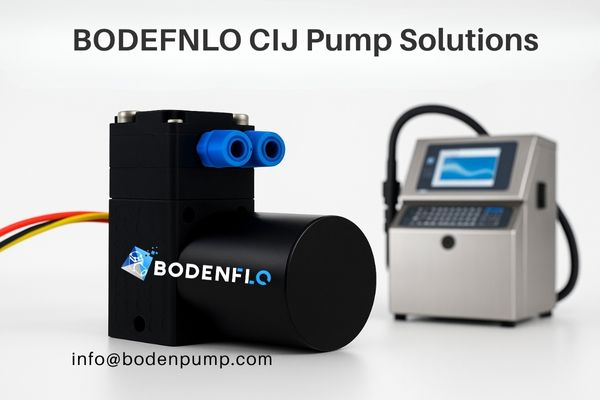
We engineer pumps to match specific application needs. For most standard CIJ printers with 600ml ink tanks, the BD-05TF700WB is the perfect workhorse. Its 700 mL/min flow rate can turn over the entire tank more than once per minute, providing excellent agitation.
For larger systems, or those requiring even more aggressive circulation or faster system priming, the BD-05TF3000WB is the high-performance choice. With over four times the flow rate and double the continuous pressure capability, it offers an unmatched level of performance and reliability for the most demanding CIJ applications. Both models feature long-life brushless motors rated for 6000-8000 hours of continuous operation.
BODENFLO CIJ Circulation Pump Comparison
| Feature | BD-05TF700WB (Standard) | BD-05TF3000WB (High-Performance) |
|---|---|---|
| Max Flow Rate | 700 mL/min | 3 L/min (3000 mL/min) |
| Suction | 4 mWg | 4 mWg |
| Pressure | 10 mWg (~1 bar) | 20 mWg (~2 bar) |
| Best For | Standard 600ml CIJ Systems | Large Volume / High-Demand Systems |
Conclusion: The Right Pump Means a Reliable Printer
A robust diaphragm circulation pump is the hero of a white ink printer, preventing clogs and ensuring the entire system runs reliably with perfect ink.
Looking for a circulation pump for your industrial inkjet or coding application? BODENFLO offers purpose-built diaphragm pumps designed for chemical resistance and long-term reliability.
📧 Contact us at info@bodenpump.com to discuss your system's needs.
-
Understanding the challenges of white ink can help improve printing techniques and avoid common issues. ↩
-
Exploring the role of titanium dioxide can provide insights into its effectiveness and alternatives in ink formulations. ↩
-
Learning about ink reservoirs can enhance your knowledge of printing systems and their maintenance. ↩
-
Explore the benefits of diaphragm pumps in ink systems to understand their role in maintaining quality and efficiency. ↩
-
Learn about the impact of heavy TiO₂ pigments on ink to enhance your understanding of their role in printing applications. ↩
-
Discover how positive displacement action functions in pumps, ensuring efficient handling of various materials, including inks. ↩
-
Understanding chemical fine-tuning can enhance your knowledge of printing processes and improve print quality. ↩
-
Exploring the impact of ink viscosity can help you optimize printing results and prevent issues. ↩
-
Learning about micro diaphragm pumps can provide insights into advanced printing technologies and their benefits. ↩
-
Learn about the importance of durability and chemical resistance to ensure long-lasting pump performance in harsh conditions. ↩

